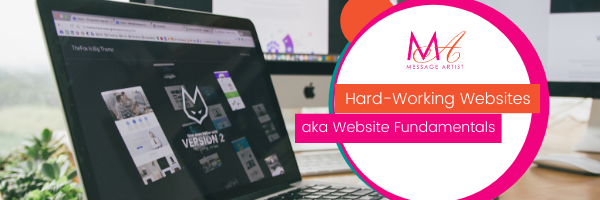Websites. The doors to all things on the internet. Sometimes they feel like they make the world go round. And in the world of business, it’s almost true. They’re certainly a crucial tool in our marketing toolbox. For me, I’ve always looked at websites as the online version of a brick and mortar store — it’s the storefront and the store all rolled into one. A hard-working website will catch a customer’s eye and then invite them in to see and learn more, and ultimately buy our products and services.
Google tells me there are 1.5 BILLION websites today. That’s a staggering number. Of course, that’s worldwide, so when we step back from that big number, we can realize that none of us are actually competing with 1.5 billion sites … but we ARE still competing with a large number of them. None of us are doing anything truly one-of-a-kind. We all know who else is selling a product or service that is similar in flavor to ours. This is why it’s so important to have your messaging down — it helps you stand out and differentiates you from anyone else doing similar. And your website is your biggest asset when it comes to doing just that.
The Big Why of Websites
I often talk about the Big Why when it comes to our messaging, but websites have big whys, too. The big whys of websites are:
- Enable you to be found in the sea of information, distractions, and websites that is the world wide web.
- Showcase your expertise and unique way of doing business in a way that resonates with your ideal customers.
- Provide info that visitors find valuable and actionable when it comes to buying your products and services.
But the thing is, too many small and mid-sized businesses don’t pay enough attention to their websites. Once they go live — even if the original plan was to redesign/redo in a couple years — too many tend to just forget about them. They forget that just as their business grows, shifts, and provides new offerings, the website must also grow, shift, and provide new information. (Let’s not forget, search engines LOVE a site that is regularly updated with new content, which translates into those sites organically showing up higher in search results.)
Although there are no hard and fast rules about redoing/redesigning websites, it’s generally recommended to do so every 2-4 years, depending on your business, the complexity of your site, and whether or not it’s continuing to work hard for you.
Assessing Your Website

Your website has many jobs. If it’s written and structured correctly, it can easily execute each of these jobs well. It has to be more than just a web page with your business name on it. It has to be a well-honed work horse that delivers what you decide it must deliver based on its main and secondary objectives.
If you haven’t looked closely at your site in a while and assessed it’s efficacy, it’s time to ask … does your website:
- Regularly draw new visitors and immediately engage them?
- Provide valuable information to your ideal client/customer leads in a way that clearly guides them where you want them to go? (Aka responding to the call to action (CTA) you want them to take.)
- Convey that you’re an expert at what you do and that you offer the best solution to their problem?
- Clearly describe how customers can buy your product or service?
- Provide multiple ways to interact and keep in touch? (your contact page and links to social sites)
- Broadcast your UVP (unique value proposition), helping you stand out from your competition?
- Provide a compelling way for people to sign up for your email list?
If there isn’t a resounding “YES!” after each of those bullet points, there’s at least one or two things on your website that require your attention.
The Components of a Hard-Working Website
There are some fundamental components when it comes to creating a successful and hard-working website. These components can be your jumping off point to assessing the health of your website.
Non-Negotiable Pages
There are some key pages that no website should be without: Home, About, Products/Services/Programs, Testimonials, Contact, Events Calendar (if appropriate.) There are, of course, more options, but these are the bare minimum and are often enough for small businesses and entrepreneurs.
And when it comes to your About page, remember, it’s actually NOT all about you. It’s about what the customer wants and needs to know. (This is actually the next blog’s topic, so stay tuned!)
Content SEO
Content SEO (search engine optimization) refers to creating content (copy, graphics, and video) that helps your web pages rank higher in search engine results. It includes both the content and the structuring of the content on your website. The three major elements of content SEO you need to consider to help your website rank higher are: keyword strategy, site structure, and copywriting.
A well-designed website with a great user interface and fun technical stuff can be there, but without good quality copy content, your site does not stand a chance in the search engines. There’s a method and skill to making sure copy content is appealing to both your visitors/customers and the search engine bots! It’s why I always recommend hiring a copywriter to help you with your website copy. Good copywriters understand how to write with SEO in mind, and it can make an enormous difference in your results. (Of course, also hiring an SEO expert when you hire your copywriter takes things into the best scenario!)

Don’t Forget These Website Must-Haves!
- A way to grow your email list
- Accurate and complete contact info, preferably including an email form and/or a way to schedule a call as easy ways to get in touch
- CTAs on every page (a prompt to learn more, download something, contact you, sign up for your newsletter, register for an event, purchase something, etc.)
- A blog (video, written, or both)
- Links to the social platforms you use for business
So, How Do You Create a Hard-Working Website?
I know, it’s a lot.
I also know of many small businesses that are trying to make do with a Facebook business page or Etsy site. Etsy can work well enough for certain types of businesses, but for the majority, it work work. As for using only Facebook, it’s really NOT a good idea. Yes, it has a lot of followers, but not everyone is on it. In fact, there are too many people who aren’t on Facebook, especially a younger generation (anyone in their teens, 20s, and some young 30s), so you’re limiting yourself. Additionally, Facebook does not have the capacity to fully tell your story, convey your brand message, and expand your reach.
It Helps to Get Help

It’s a really good idea to outsource content creation and the design and build of your website. You started a business to offer a specific service or products and it’s highly likely that writing marketing copy or designing a website isn’t your strong suit, otherwise, you’d have started a copywriting or web design business!
That said, I always tell clients, do what you have to do to get started. It’s better to start imperfectly than not start at all. Once you have some cash flow, then you can find the right resources to help you create the website that will work hard for you and deliver what you need it to deliver.
If you are ready to get some help with your website content, or simply want to learn more so you can plan for it in the future, go ahead and schedule some time with me and let’s talk about how we can make your site work as hard for you as it is supposed to do.



0 Comments